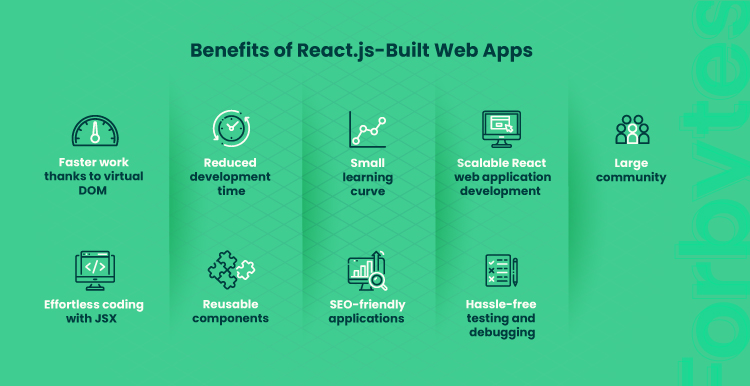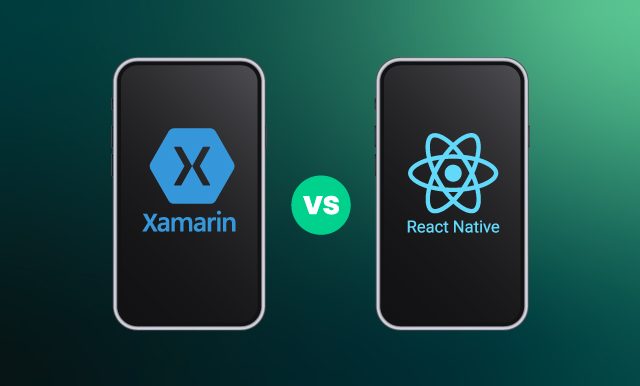In the past, web developers have relied on a variety of different frameworks and libraries to build user interfaces. However, the emergence of React.js has changed all that. React is a JavaScript library that allows developers to create user interfaces that are both fast and reactive.
If you are planning to develop a web application, it is important to consider whether React.js would be a good fit for your project. In this article, we will discuss some of the key reasons to use React.js for your next web development project.
What Are Front-End Frameworks?
Front-end web development frameworks are software libraries that provide pre-written code to help developers build websites and web applications. The code in a framework is typically written in HTML, CSS, and JavaScript. Using the framework, developers can save time by reusing code that has already been written and tested. In addition, they can take advantage of code libraries, which offer ready-made solutions to common development problems. While each framework has its own unique features and syntax, they all share the goal of simplifying the development process.
Each framework has its own unique benefits, so it’s important to choose the right one for your project. If you’re looking for a powerful framework that can handle complex user interfaces, then AngularJS is a good option. If you need a lightweight framework that’s easy to learn, then React might be a better choice. And if you want a framework that’s versatile and can be used for both mobile and web development, then Vue.js could be the perfect option.
In order to tackle frequent issues that developers run into when scaling or expanding a web application, frameworks are used. Management of the user interface, user events, the DOM, and forms are a few examples. In addition, starting a codebase with a framework makes it easier to integrate new contributors. Frameworks offer modularity to applications as well. They enable you to assemble your user interface from components. A component is made up of all the HTML, JS, and CSS code that is specialized to a particular need and may be applied to different user interfaces.
React.js: The Fundamentals
React is a powerful JavaScript library for building user interfaces. It is declarative, component-based, and easy to learn. React was created by Facebook in 2013, and it has been gaining popularity ever since. In 2016, React was the most-starred JavaScript library on GitHub. One of the reasons for React’s popularity is its simplicity. React allows you to create reusable components used in multiple places in your code. This makes your code more modular and easier to maintain. React also has a strong community behind it, with many developer tools and libraries available.
Unlike other front-end JavaScript frameworks, React.js doesn’t use templates to generate HTML. Instead, it uses a virtual DOM (Document Object Model) to keep track of changes in the UI. This makes React.js more efficient and fast, as it only updates the parts of the DOM that have changed rather than re-rendering the entire UI. React.js is also component-based, which means that complex UIs can be built by combining small, reusable components. This makes code more modular and easier to maintain. Finally, React.js is declarative, meaning that developers don’t have to worry about the order of execution, making code easier to read and understand. In summary, React.js is a powerful front-end JavaScript framework that is fast, efficient, and easy to use.
React.js VS React Native
React.js and React Native are two popular choices for front-end development, but which one is better? React.js is a JavaScript library for building user interfaces, while React Native is a framework for creating mobile apps. Both have their pros and cons, but in general, React.js is better suited for web development, and React Native is better for mobile app development.
React.js offers a declarative syntax that makes it easy to create complex user interfaces. It also has a large community of developers and a well-established ecosystem of third-party libraries. However, React.js only works with web browsers and cannot be used to create native mobile apps.
React Native, on the other hand, can be used to create cross-platform mobile apps that can be deployed on both iOS and Android devices. It uses the same UI components as React.js but translates them into native code that can run on a mobile device. This allows React Native apps to have a native feel without sacrificing the portability of JavaScript code. React Native does have some limitations compared to fully native app development frameworks such as Swift or Java, so it may not be the best choice for large or complex applications.
Why Use React.js for Web Development?
The many benefits of using React include its modularity, reusable components, one-way data binding, virtual DOM, and many more. Let’s talk about them in more detail.
Increased Productivity Thanks to Virtual DOM
There are many advantages to building web applications using React.js, but one of the most noteworthy is the speed boost that comes from using a virtual DOM. Traditional web applications rely on the browser’s DOM to keep track of changes to the UI. This can be slow and cumbersome, especially when there are many UI elements that need to be updated frequently. With React, the virtual DOM takes care of all of this tracking for you, which means that your application will be much faster and more responsive.
In addition, because the virtual DOM is a JavaScript object, it can be easily serialized and stored for later use. This makes it easy to create truly stateless components, which can further improve performance. Ultimately, the speed and efficiency benefits of using a virtual DOM make React an excellent choice for building modern web applications.
Smooth Coding with JSX
One of the advantages of React is that it uses JSX, a syntax extension to JavaScript that makes it easy to combine HTML and JavaScript. This makes React code more readable and easier to write, which reduces the amount of time spent on coding and helps prevent errors. In addition, using JSX with React can help improve the performance of web applications by making it easier to optimize code for different browsers. JSX also makes it easy to create reusable components, which can save time and improve maintainability.
Shorter Development Period
One major advantage of using React.js is that it reduces development time. This is because React.js components are reusable, so developers don’t have to start from scratch each time they want to create a new component. In addition, React.js provides hot reloading, which allows developers to see changes they make to the code immediately without refreshing the page. This makes it easy to test small changes and iterate quickly on features. As a result, React.js can help reduce the overall development time for web applications.
Reusable Components
React.js promotes the creation of reusable components. This means that developers can write code once and use it multiple times, which can save a lot of time and effort. In addition, because React components are self-contained, they are easy to reuse in different projects or even share with other developers.
The use of reusable components can also lead to more consistent and reliable code. When all of the code for a project is written in one place, it is easier to spot errors and ensure that everything works as intended.
When constructing a web application with React.js, programmers have access to a variety of components and features:
- Function component. This straightforward JavaScript function may accept input and output HTML code.
- Class component. The complexity of this kind of component is higher. It is a class that uses more intricate syntax. Class components can include a variety of operations to give a React.js web application exceptional capability.
- React hooks. Thanks to useful new features, this innovative idea takes the place of class components. Access to functional components is made possible by React hooks without the need for classes.
Small Learning Curve
When it comes to web development, there are a lot of different options to choose from. However, React.js has become one of the most popular choices in recent years thanks to its small learning curve. One of the biggest benefits of React is that it uses a declarative style of programming. This means that developers can simply specify what they want their code to do without having to worry about the underlying implementation details. As a result, React code is usually much simpler and easier to understand than code written in other frameworks.
In addition, React provides a number of helpful tools and libraries that make development faster and easier. For example, the Create React App tool can be used to create a new React project with all the necessary dependencies already installed. These features make React an ideal choice for beginners who are just starting out in web development.
SEO-Friendly Applications
Web applications come in all shapes and sizes, but one commonality between them is the need to be SEO-friendly. That’s where React.js comes in. React.js provides a number of features that make it ideal for SEO. For example, React.js uses a virtual DOM, which means that changes to the UI are first made in an abstract representation of the DOM before being applied to the actual DOM. This results in fewer page reloads, which can help to improve crawlability and reduce server load times.
Furthermore, React.js components are self-contained, which means they can be easily reused and packaged as standalone modules. This modularity makes it easier for search engines to index your content, and it also helps keep your code clean and organized. As a result, web applications built with React.js are more likely to rank highly in search engine results pages.
Finally, React Helmet can be used to manage and dynamically update document head elements, giving developers fine-grained control over their application’s SEO.
Effortless Testing and Debugging
One of the reasons for its popularity is that React.js features a powerful set of tools for testing and debugging.
React.js components are usually small and independent, which makes them easy to test in isolation. This isolation also makes it easier to identify bugs because they are less likely to be caused by interactions between different components. React.js also includes a built-in JavaScript debugger that can be used to debug React code. This debugger provides a view of the component hierarchy and the props and state variables associated with each component.
Finally, React also provides a snapshot testing tool that can be used to automatically generate tests that check whether the output of a React component matches an expected result. This tool can be particularly helpful when debugging changes to a React component that are not easily observable in the browser.
Big Community
Any developer who has been around the block a few times knows that one of the most important things to consider when choosing a technology is the size and strength of the community that surrounds it. After all, when things go wrong (and they always do), it’s good to know that there are others out there who have likely encountered the same problem and can offer guidance on how to fix it. This is one of the major advantages of React.js, which is developed and maintained by Facebook. With millions of users, Facebook has amassed a large community of developers who are familiar with React and its paradigms.
Developers who choose to build their web applications using React can be confident that they will have access to a wealth of resources and expertise should they need it. With over 1,000 contributors on GitHub, there is a wealth of support and resources available for developers who are using React.js. In addition, because React.js is an open-source project, there is a constant stream of new features and updates being released. This makes it an attractive option for developers who want to keep up with the latest trends in web development.
Flux and Redux
Any React developer will tell you that one of the most challenging aspects of building a React app is managing state. From simple React components to large-scale applications, every React app has some level of state that needs to be managed. This is where Flux and Redux come in. Both Flux and Redux are tools that help manage state in React applications. However, they have different approaches. Flux uses a unidirectional data flow, while Redux uses a multidirectional data flow. Additionally, Flux has a Dispatcher component, while Redux does not. While both tools have their own advantages and disadvantages, they are powerful tools that can help any React developer build robust applications.
Both React.js and React Native have their own strengths and weaknesses. If you need to develop a front-end application that will work on both web and mobile devices, React Native is probably the best choice. However, if you only need to develop for the web or if you want more control over native features such as access to specific device hardware, then React.js would be a better option.
Challenges Developers Face While Using React.js
React.js does have some drawbacks, despite the fact that it has many advantages. Before building your web app, it’s crucial to take them into account. Let’s go over the primary roadblocks that could delay the development process so you won’t be surprised by any unforeseen problems.
- User-friendly documentation is lacking. The Internet is a wealth of knowledge when it comes to React.js. However, as some records can be missing or be partial, it might be difficult to locate comprehensive material from official sources. As a result, in order to find the necessary knowledge on writing code or utilizing new capabilities, developers may need to perform extensive studies. Additionally, when reading the official React.js documentation, it can be challenging to find solutions to particular problems.
- React.js for web apps is a frontend library. React.js’s status as a JavaScript library rather than a framework like Angular and Vue.js presents another drawback. When using a framework, software engineers must adhere to a particular format. Frameworks provide the advantage of standardization, allowing any developer to rapidly join a team and begin working on a project right away.
Software developers can import any library and call any component or method because React.js is a frontend library. So, while utilizing React, there are countless possibilities available. However, the variety of libraries makes the process of finding and hiring new developers more challenging. Your team’s current software engineers might have to spend a lot of time looking up libraries to use.
For example, when designing elements and component libraries, developers should take state management into account. They will need to decide which language to utilize, as well as routing and server-side techniques. There is a choice between TypeScript and JavaScript. When adding new developers to your team, you should be aware that they might not be able to begin working on your project right immediately because they require some time to become accustomed to the technology stack.
Despite the above-mentioned challenges, React.js is the second most popular web framework among developers worldwide in 2022.
Developing Web Applications Using ReactJS
ReactJS is designed to be lightweight and easy to use, making it a popular choice for developers. When used with other libraries and frameworks, ReactJS can help you build rich and interactive web applications. In addition, ReactJS is open source and free to use, making it an accessible option for developers of all levels.
React.js has been used by several prosperous businesses to create their web applications, including:
- Meta Inc. (formerly Facebook Inc.) The React.js library was created by Meta Inc., and its software engineers used it to create the Facebook web interface.
- Instagram. Instagram, a social media platform with enormous popularity, also has a React.js web application. The web interface of the application is built primarily with the React library.
- Netflix. React.js was chosen by Netflix in 2015 to rebuild the user interface of their primary website. This choice improved the streaming service’s performance and loading times.
- Airbnb. Developers at Airbnb use React.js. One of the main aspects that persuaded them to convert to this technology was the capacity to reuse components.
- PayPal. React.js is used to make the user interface of one of the most widely used platforms for money transfers operate quickly.
- Walmart. A lot of individuals shop online at Walmart using their website. For the Walmart website to maximize conversion rates, speed is a key component. Because of this, their developers chose React.js.
- Tesla. React.js is the best technology for the user interface of Tesla’s website, which is a foresightful business that employs it.
Final Word
React.js has emerged as one of the most popular frameworks for building web applications. Thanks to its flexibility and ease of use, React.js has been adopted by a wide range of companies, from small startups to large enterprises. While React.js is not suitable for every project, it is a great choice for many types of web applications.
Need help with growing your next digital project? Forbytes assists businesses all over the world in building fresh digital products, enhancing their corporate objectives, and innovating within their industry. Whether you’re just starting out or you’re looking to take your business to the next level, we can provide the support you need — so contact us today.

Our Engineers
Can Help
Are you ready to discover all benefits of running a business in the digital era?

Our Engineers
Can Help
Are you ready to discover all benefits of running a business in the digital era?









